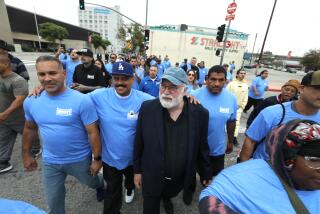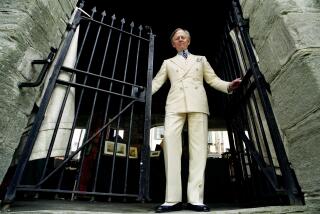For family and friends of James Foley, ‘Jim’ is a mark of the man
PARK CITY, Utah — John Foley felt a complicated set of emotions when he viewed the now infamous video of his son, the journalist James Wright Foley, being executed by Islamic State 18 months ago.
“Despite the world watching, I felt so bad he was alone and none of us were there,” John said in an interview with his wife Diane at a restaurant here last week. “I only pray that, even though he was physically alone, he died with the memories of all those who loved him.”
A tear then came to John’s eye. “It was horrific,” he said, his voice wavering. “But seeing Jimmy’s lips like that in the video, I could see his courage. I could feel his courage.
See more of Entertainment’s top stories on Facebook >>
To many Americans, James Foley is a piece of shorthand, a symbol, the orange-jumpsuited man in the grotesque footage that drove home the danger of ISIS at the dawn of its threat.
To the Foleys, he represented something else: Jimmy, a brave and pure-hearted idealist, the son who made them proud, if more than a little anxious, with every new adventure he embarked upon. Their son--held prisoner for nearly two years before his death, in Syria, at age 40--was pursuing a task that was dangerous but important. They came to embrace his choice even as it led, with a kind of horrible slow-motion velocity, to the unthinkable.
The rest of America might start to feel a little more like the Foleys upon watching “Jim.” Directed by Brian Oakes, a film-graphics veteran and the subject’s childhood friend, the documentary is an intimate homage to a deeply likable man — and a reminder that, for all its high-level policy wrangling, the war on terror is just as often about the confused and heartbroken family next door.
After premiering last week at the Sundance Film Festival, where it won a major audience prize, “Jim” will debut on HBO Saturday night. The film paints the native of small-town New Hampshire as a rich human being, one innately driven to take risks in the name of truth.
“I remember as I became more aware of the dangers, asking him, ‘Why are you doing this?’ You have two master’s degrees — why?’ Diane Foley, with her trademark mix of resolute and self-questioning tones, said as she sat near her husband. “And he said, ‘Mom, you have to understand my passion.’ He became more excited just talking about it. And that’s when I began to understand.”
The Marquette- and Medill-educated Foley was a free spirit — so caught up did he become in the moment that he often arrived hours late to appointments and rarely packed a toothbrush, the film recalls. Foley took some time in early adulthood figuring out his life purpose. He volunteered with Teach for America; he taught writing to prison inmates in the Chicago area.
As the Iraq war progressed, however, Foley felt the need to be closer to, and communicate from, intense global conflicts. He embedded with the Indiana National Guard as a broadcast journalist, then shortly afterward, he traveled as a freelancer with a small group of international reporter friends to chronicle the 2011 revolution in Libya. Foley was captured there and survived more than 40 days as a hostage before being freed in a negotiated release.
The journalist returned home to his tightknit family — he is the eldest of five siblings and was especially close to his more pragmatic brother Michael, a key voice in the film — but found himself bored with a desk-editing job. He soon returned to a combat zone. In late 2012, he was captured while working in war-torn northern Syria.
The second half of “Jim” is devoted to showing what Foley’s life was like in a harsh prison setting. More than a dozen European journalists were held captive with him at various points; apart from the British nationals, all were released. Their voices here offer an uncommonly detailed look at life as a Westerner behind ISIS lines.
There were the board games the prisoners invented out of basic raw material. The oranges they coveted like candy. And, of course, there were the torture sessions. As one former captive says in the movie, it wasn’t the physical pain as much as the psychological uncertainty. (If offered the choice between the relief of a “stress-killer” pill or a “pain-killer” pill, he says, he would unquestioningly take the former.)
A perennial optimist, Foley was a steady presence throughout. At a time when a brute need for survival brought out the worst in prisoners, he was frequently helpful and supportive, even if it meant pushing down his own pain.
“The most poignant moment, and the one that drove home Jimmy’s spirit to me watching the film, was when some people weren’t certain about whether they would be released, and Jimmy put his arm around them and supported them even though he knew he would never be released,” said John Foley, a soft-spoken doctor with a New Hampshire accent. “That was the essence of Jim,” he added, beginning to choke up once more.
Oakes, who knew Jim Foley well from their New Hampshire town, said, “He was just that guy you always wanted around. Whenever Jim entered that room, he didn’t have to say anything. He just changed the environment.”
If the movie elides the question of whether there was a more traditional way for Foley to be practicing overseas journalism, it also makes clear the benefits that came from his fearlessness. Foley and his colleagues were among the first to transmit horrific images and stories, now conveyed via the likes of the Homs drone, from the dangerous region where few dared to travel. (One of the goals of the foundation that Diane and John formed after their son’s death is to provide a better safety net for the growing number of freelance journalists in conflict areas.)
Hovering above the movie are several what-ifs, particularly with regard to the strict hostage-negotiation policy of the U.S. Though John and Diane Foley decline to speak of it these days, there is a palpable sense of frustration in the film about the government’s efforts. As Foley’s editor notes with a bittersweet trace in his voice, the Europeans were all released.
Some viewers might also ask why a civilian was in a hot zone like Syria, especially after cheating death in Libya just a short time before. But this was never a question for Foley, and the film argues it shouldn’t be for us either. As a Foley friend, in an analogy befitting cinema’s current “Spotlight” moment, says in the movie, you would never question a fireman who rushes into a burning building to do his job. Why would you do the same for a journalist?
For Foley’s parents, this is, understandably, a more delicate issue.
“It was so hard to have Jimmy home from Libya,” John said. “We didn’t want to push him. But I still feel like sometimes maybe we should have laid more guilt, like that might have stopped him from going back overseas.”
“We could have laid more guilt,” Diane said quietly.
At an HBO-backed screening of the film hosted by the Council of Foreign Relations and attended by top Time Warner executives earlier this week, the Foleys turned out, along with some of their children, to help keep Jim Foley’s legacy alive. John and Diane bravely watched the movie once more and then, when it was over, stood in front of the cocktail-party set to explain how they were trying to carry on their son’s mission. Some fatigue was evident on their faces. However impossible it is to conceive of what parents like the Foleys went through, imagining how it feels to re-live it in the name of a cause seems that much more difficult.
The moment that will emotionally wreck even the most steely soul comes during the movie’s conclusion, when Jim’s brother Michael reads a letter--written just before Foley was executed and memorized by a captor about to be released--that serves as a kind of epilogue and farewell. In it, the journalist offers a heartfelt reminder to each of his close family members about what he loves and remembers about them — the hug he gave one brother outside a comedy club, the foibles of his grandmother.
“You realize you don’t know your children when they become adults,” said Diane, taking a deep breath as she recounted some of the textured details in “Jim.” “They go off and have their jobs and their friends, and a lot of that is a mystery to parents.”
“We came to know Jimmy from the film,” said John.
More to Read
The complete guide to home viewing
Get Screen Gab for everything about the TV shows and streaming movies everyone’s talking about.
You may occasionally receive promotional content from the Los Angeles Times.







